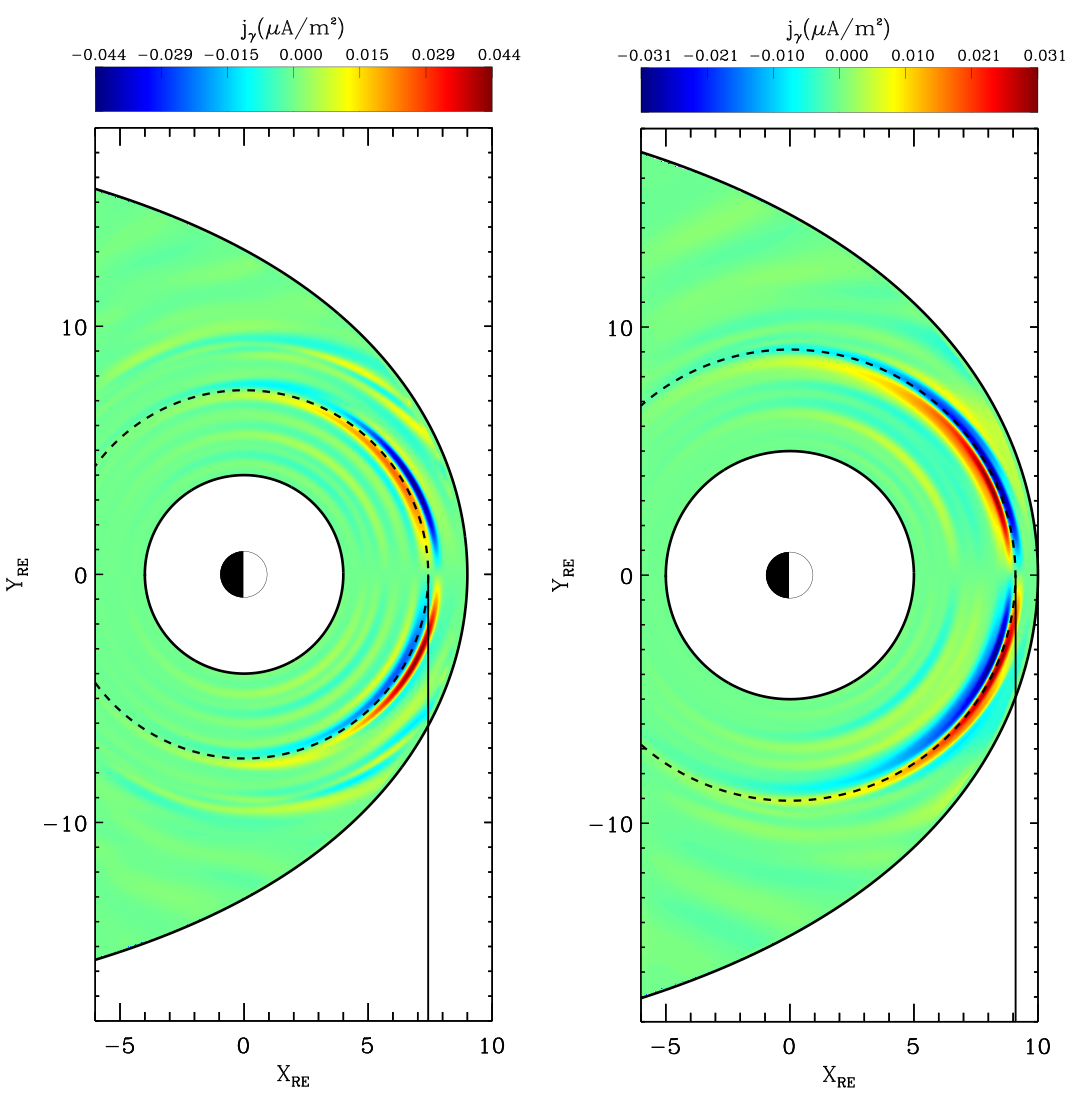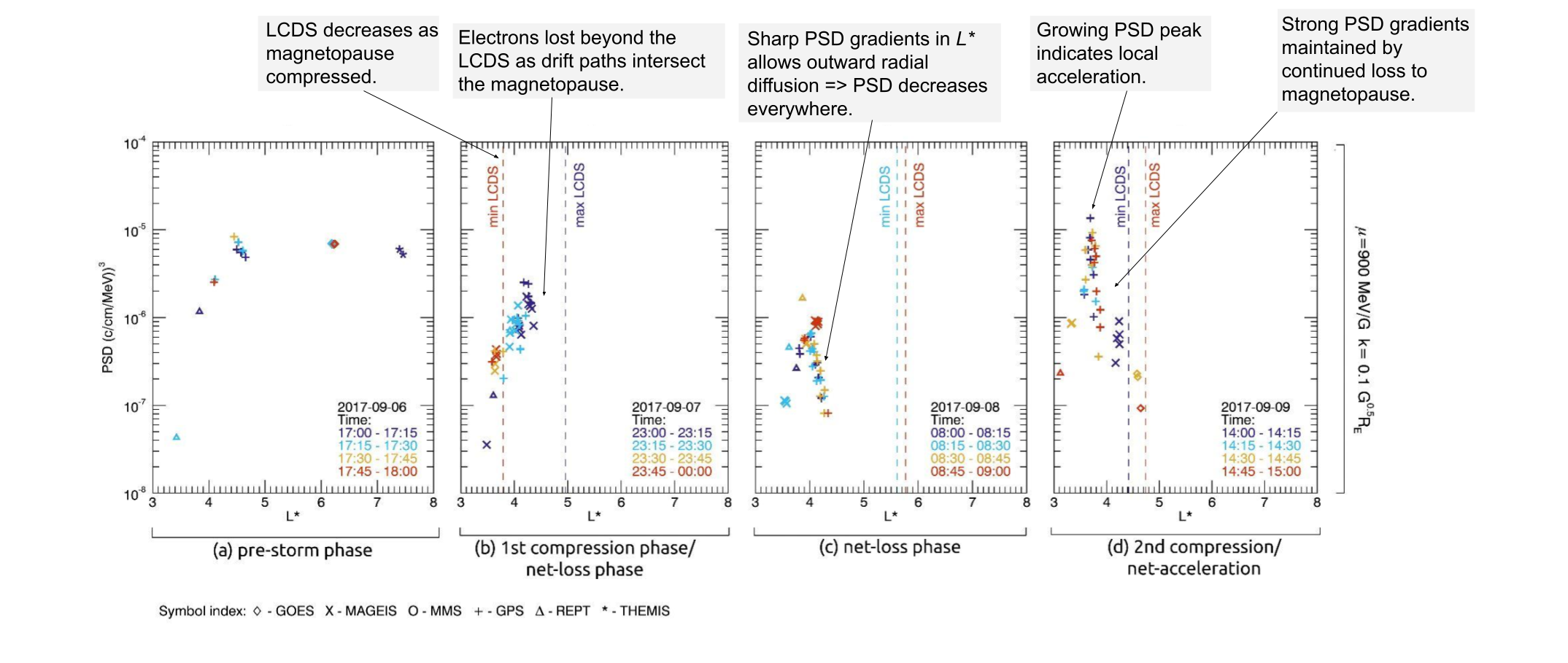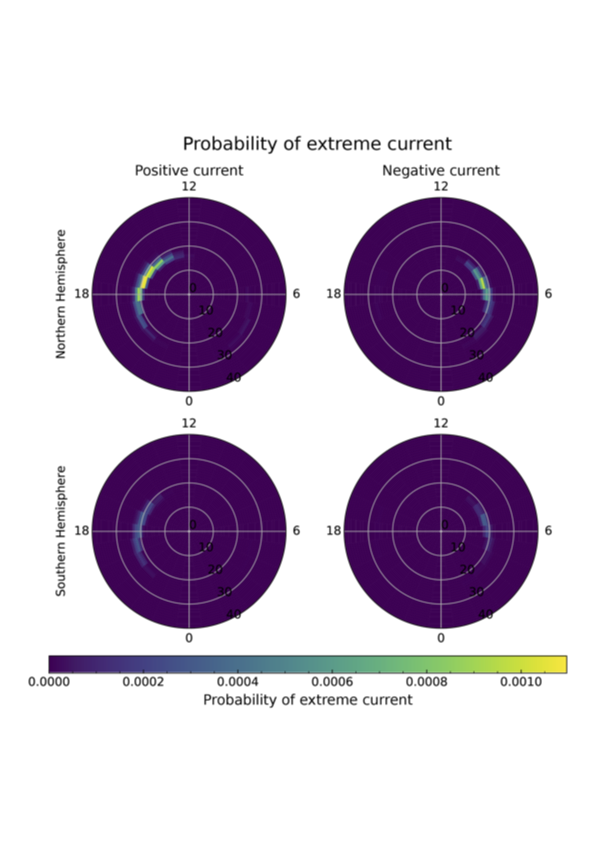MIST
Magnetosphere, Ionosphere and Solar-Terrestrial
Nuggets of MIST science, summarising recent papers from the UK MIST community in a bitesize format.
If you would like to submit a nugget, please fill in the following form: https://forms.gle/Pn3mL73kHLn4VEZ66 and we will arrange a slot for you in the schedule. Nuggets should be 100–300 words long and include a figure/animation. Please get in touch!
If you have any issues with the form, please contact This email address is being protected from spambots. You need JavaScript enabled to view it..
Saturn's Weather‐Driven Aurorae Modulate Oscillations in the Magnetic Field and Radio Emissions
By Nahid Chowdhury (University of Leicester)
Planetary parameters at Saturn have exhibited mysterious time variabilities and periodicities for almost two decades. After the first Voyager measurements of the 1980s led to a determination of a rotation rate for the ringed planet, the advent of the Cassini mission in the 2000s showed that the measured length of a day at Saturn was subject to change. Numerous theories were proposed to explain the time variabilities seen in planetary parameters ranging from the radio emission through to the energies of neutral atoms and these fell into one of two general categories. The first was that a driving mechanism for the observed periodic behaviour would be situated externally to the planet, within the magnetosphere. The second was that a driving mechanism would be situated within the planet’s atmosphere.
Using infrared observations of Saturn’s northern polar auroral H3+ emission taken with Keck-NIRSPEC in 2017, we investigated ion flows in our search for a signature of the twin-vortex mechanism in the planet’s upper atmosphere that was purported to drive the observed periodicities. H3+ is an ion found in the ionosphere of gas giant planets and measurements of its line-of-sight velocity are indicative of the more general motion of constituents in the planet’s atmosphere.
By grouping our spectral data into quadrants of local northern planetary magnetic phase, we set up our experiment to probe the ion flows driven by the planetary period current. This led to the astonishing detection of the proposed ionospheric twin-vortices that are considered to be responsible for the periodicities witnessed throughout Saturn’s planetary and magnetospheric environments. Our observations show that local atmospheric weather effects at Saturn drive the twin-vortex flows while also generating some auroral emissions. This result has far-reaching implications for both other planets in our Solar System and exoplanetary systems.

Figure caption: Shown here is an example of the type of winds within the upper atmosphere that are driving the ionosphere to move in the way observed in this new paper. This set of two vortices rotate around the pole of the planet, driving currents within the ionosphere, which then reach out into the surrounding magnetosphere, producing the bright aurora and magnetic field changes observed by Cassini. This weather system was originally proposed by Chris Smith in a paper in Monthly Notices of the Royal Astronomical Society in 2011 (doi:10.1111/j.1365-2966.2010.17602.x) – and it is these modelled flows that we show here.
Please see paper for full details: Chowdhury, M.N., Stallard, T.S., Baines, K.H., Provan, G., Melin, H., Hunt, G.J., Moore, L., O’Donoghue, J., Thomas, E.M., Wang, R. and Miller, S., 2022. Saturn's Weather‐Driven Aurorae Modulate Oscillations in the Magnetic Field and Radio Emissions. Geophysical Research Letters, 49(3), p.e2021GL096492. DOI: https://doi.org/10.1029/2021GL096492.
Modelling the Varying Location of Field Line Resonances During Geomagnetic Storms
By Tom Elsden (University of Glasgow)
Field line resonances (FLRs) are the manifestation of a magnetohydrodynamic (MHD) wave coupling process where energy is transferred from a global to local field-aligned wave. The ‘resonance’ comes from a frequency matching between these waves and being a resonant process, can result in a significant accumulation of energy on a given field line. These waves play an important role in magnetospheric wave-particle interactions, the generation of aurora and can further be used as a seismological tool to remote sense the magnetosphere from ground-based observations.
The location where FLRs occur is intrinsically linked to the current state of the magnetosphere, with the magnetic field structure, plasma density and solar wind driving conditions all being key factors. Given the drastic effect of a geomagnetic storm on the morphology of the magnetosphere, we considered how such changes impact where FLRs form between storm and non-storm times.
We used ground magnetometer data to determine how the fundamental Alfven frequency of field lines varies over the course of a storm on average. These frequencies were then used to infer a plasma density profile to be used in a numerical MHD model to investigate where the FLRs would form under broadband solar wind driving conditions.
Figure 1 shows results from these simulations, displaying the field-aligned current density as an indication of FLRs, mapped from the ionosphere to the equatorial plane to display the radial structure. The left panel is from a simulation modelling the initial phase of a storm, with the right panel modelling the main phase. We show that for an average storm, the FLR moves radially inward by ~1.7RE (compare vertical line locations). This is caused by a decrease in the fundamental Alfven frequency as well as an increase in the global (fast) wave frequency which drives the FLRs.
The important aspect of the results is the overall trend of more Earthward FLR formation during storms. Particularly if extrapolated to more severe storms, this could have an impact on storm-time wave-particle interactions in the radiation belts.

Figure 1 Caption: Colour contours of field-aligned current density from near the ionospheric end of field lines, mapped to the equatorial plane. Left: simulation modelling storm initial phase. Right: simulation modelling storm main phase. Vertical lines indicate field line resonance locations.
Please see paper for full details: Elsden, T., Yeoman, T. K., Wharton, S. J., Rae, I. J., Sandhu, J. K., Walach, M.-T., et al. (2022). Modeling the varying location of field line resonances during geomagnetic storms. Journal of Geophysical Research: Space Physics, 127, e2021JA029804. https://doi.org/10.1029/2021JA029804
Resolving Magnetopause Shadowing Using Multimission Measurements of Phase Space Density
By Frankie Staples (formerly at MSSL UCL, now at UCLA)
Loss mechanisms act independently or in unison to drive rapid loss of electrons from the radiation belts. Electrons may be lost by precipitation into the Earth’s atmosphere, or through the magnetopause into interplanetary space – a process known as magnetopause shadowing. The mechanisms by which electrons are lost may be identified through changes to electron phase space density (PSD). This method considers the number of particles at given adiabatic coordinates (𝝁, K, and L*), which relate the electron energy, pitch angle, and location in the magnetic field. The characteristics of PSD evolution as a function of L* can be used to identify which loss mechanism is acting. However, the rapid nature of electron flux dropouts make it extremely difficult to resolve PSD dynamics at the necessary timescales to identify the contributions of either loss mechanism.
In this study we used a new multimission dataset of PSD observations from 36 satellites to resolve the dynamics of a magnetopause shadowing induced flux dropout in September 2017. We showed that by using Van Allen Probe data alone, the physical processes causing the dropout could be misinterpreted due to limited time and/or spatial resolution. Using multimission observations provided unprecedented time and spatial resolution necessary to correctly interpret PSD dynamics.
The labelled Figure shows the magnetopause shadowing characteristics identified in PSD observations. Each panel shows PSD as a function of L* for fixed μ = 900 MeV/G and K = 0.1 G0.5RE at 1-hour intervals through phases of the storm. Symbol colours indicate when measurements were taken within the hour period, and dotted lines show the minimum and maximum L* of the last closed drift shell (LCDS) before the magnetopause.

Please see paper for full details:
Staples, F. A., Kellerman, A., Murphy, K. R., Rae, I. J., Sandhu, J. K., & Forsyth, C. (2022). Resolving magnetopause shadowing using multimission measurements of phase space density. Journal of Geophysical Research: Space Physics, 127, e2021JA029298. https://doi.org/10.1029/2021JA029298
Distributions of Birkeland current density observed by AMPERE are heavy‐tailed or long‐tailed
Electric currents flow above Earth’s surface in the ionosphere; along the magnetopause; across the magnetotail; and in the same region of space as the radiation belts. These currents are all closed through currents flowing along the magnetic field lines in near-Earth space forming one large current circuit; the currents flowing along the field lines are known as field-aligned currents, or as Birkeland currents.
Birkeland currents are, therefore, the currents that communicate impacts from the solar wind (at the magnetopause) and from phenomena such as substorms (in the magnetotail) into the ionosphere, and a key part of the puzzle in understanding phenomena such as ground-based magnetic perturbations such as GICs.
In this paper, we analyse the distributions of the Birkeland current densities measured by a dataset called AMPERE. We find that the distributions are heavy-tailed, which means that they are more likely to display extreme behaviours than if they were distributed normally. We determine that the best model to describe the distributions is a q-exponential model, and we exploit this to find the probability of currents flowing above some given threshold.
We can use this to make maps of the probability of extreme current flows in the Northern and Southern Hemispheres (Figure 1). We can see that the most extreme currents are most likely to be on the dayside of Earth, and at a magnetic colatitude of ~20° (a latitude of ~70°), and we can see that extreme currents are much more likely in the Northern Hemisphere. This has important ramifications for space weather prediction, but also for the physical drivers of the currents; more details are available in the full paper.

Acceleration of Electrons by Whistler-Mode Hiss Waves at Saturn
By Emma Woodfield (British Antarctic Survey)
Whistler-mode hiss waves are well known for causing losses of energetic electrons from the radiation belts at the Earth through wave-particle interactions. The result of the interactions of charged particle with plasma waves, whether energy is transferred from wave to particle or vice-versa, is dependent on many factors including the background plasma conditions. In Saturn’s magnetosphere there is a torus of charged particles, the primary source of this plasma torus is neutral water particles emitted from the moon Enceladus which are then ionised. The combination of pressure, ambipolar electric field, centrifugal and gravitational forces on this moon sourced plasma creates a regime where density is highest near the magnetic equator and notably lower at higher latitudes. Consequently, the ratio of plasma frequency to electron gyrofrequency frequently falls below one at higher latitudes. This also coincides with the region where hiss mode waves are observed and our simulations show that this very low ratio leads hiss waves at Saturn to accelerate electrons rather than scattering them out of the radiation belt. This new finding has important implications for the radiation belt dynamics at Saturn since hiss waves are strong and frequently observed.
Another result of the high latitude occurrence of hiss (> 25 degrees) is that only electrons which bounce a good distance along the magnetic field lines will encounter these particular wave-particle interactions. Therefore, the energy increase in the electrons due to the hiss waves is only seen in these particles. We can describe how far along the magnetic field a particle will reach using the equatorial pitch angle, which is the angle between the particle velocity and the magnetic field at the magnetic equator. An electron with an equatorial pitch angle of 90 degrees is confined to the equator whereas one of 0 or 180 degrees will reach all the way down to the planet in different hemispheres. The result of the hiss wave interactions is to drive the pitch angle distributions of the electrons towards a “butterfly shape” with peaks at low (and very high) equatorial pitch angle reflecting the hiss interactions at high latitudes in both hemispheres. The strength and speed of the interaction also varies with electron energy, the figure shows how our simulations of the electron pitch angle distributions at different L-shells (radial distance along the magnetic equator of a magnetic field line) progress after one Earth day for three typical radiation belt energies. These simulations consider only the effect of the hiss waves to isolate their effect from radial diffusion and transport and any other wave-particle interactions or collisional losses. Highly anisotropic pitch angle distributions (with the peak at lowest and highest pitch angle) are apparent in all three energies in even this relatively short timescale simulation.
![Equatorial pitch angle distributions from 2D model runs at a given L-shell after 24 hours with a resolution of 0.1L. Each run considers the energy and pitch angle diffusion, no radial diffusion or radial transport is included. Each pitch angle distribution is normalised to the flux value at 90 degrees. (a) initial condition for all energies, (b,c,d) flux at 0.4, 1.0 and 3.0 MeV respectively. From: Emma Woodfield - BAS Sent: 27 January 2022 13:50 To: Walach, Maria <m.walach@lancaster.ac.uk> Subject: RE: [External] MIST Nugget Hi Maria, Will do 😊 There’s a BAS news twitter – I’ll double check the twitter handle. Thanks Emma From: Walach, Maria <m.walach@lancaster.ac.uk> Sent: 27 January 2022 12:36 To: Emma Woodfield - BAS <emmwoo@bas.ac.uk> Subject: Re: [External] MIST Nugget Hi Emma, Great! Could you prepare one within the next 1-2 weeks? I also advertise new nuggets via the MIST twitter page. Please let me know if you have any twitter account(s) that you would like me to tag in the post or any suggested wordings. Thanks, Maria On 27 Jan 2022, at 12:29, Emma Woodfield - BAS <emmwoo@bas.ac.uk> wrote: This email originated outside the University. Check before clicking links or attachments. Hi Maria, That was a quick spot – I haven’t even checked the online version myself yet! :-) Yes happy to do a nugget, when would you like it by? Kind regards Emma From: Walach, Maria <m.walach@lancaster.ac.uk> Sent: 27 January 2022 12:28 To: Emma Woodfield - BAS <emmwoo@bas.ac.uk> Subject: MIST Nugget Hi Emma, I hope all is well with you! I am contacting you on MIST Council business, due to your recent article (https://agupubs.onlinelibrary.wiley.com/doi/abs/10.1029/2021GL096213?campaign=wolacceptedarticle). MIST nuggets are short, 1-2 paragraphs (100 - 300 words) accompanied by a figure/animation that describes the importance and some key result/aspect of your work, as well as a caption for the figure and any references.. For some examples please see http://test.mist.ac.uk/nuggets. They are aimed to be understandable for the general MIST audience - at the level of a 1st year PhD student, with a focus on clear language and the wider impact of the results. We would like to invite you to contribute to the series of MIST nuggets and provide a short nugget on your recently published work. Hopefully this should not take much time to write, and it is a great way to advertise your work to the wider MIST community! Please would you be able to let me know whether or not you will be able to contribute at your earliest convenience. Many thanks, Maria On behalf of MIST council -------------------------------------------------- Maria-Theresia Walach Senior Research Associate Space and Planetary Physics Group Physics Department Lancaster University Lancaster LA1 4YB UK This email and any attachments are intended solely for the use of the named recipients. If you are not the intended recipient you must not use, disclose, copy or distribute this email or any of its attachments and should notify the sender immediately and delete this email from your system. UK Research and Innovation (UKRI) has taken every reasonable precaution to minimise risk of this email or any attachments containing viruses or malware but the recipient should carry out its own virus and malware checks before opening the attachments. UKRI does not accept any liability for any losses or damages which the recipient may sustain due to presence of any viruses.](/images/Emma_Woodfield_20220204.png)
Figure Caption: Equatorial pitch angle distributions from 2D model runs at a given L-shell after 24 hours with a resolution of 0.1L. Each run considers the energy and pitch angle diffusion, no radial diffusion or radial transport is included. Each pitch angle distribution is normalised to the flux value at 90 degrees. (a) initial condition for all energies, (b,c,d) flux at 0.4, 1.0 and 3.0 MeV respectively.
See full paper for details:
Woodfield, E. E., Glauert, S. A., Menietti, J. D., Horne, R. B., Kavanagh, A. J., & Shprits, Y. Y. (2022). Acceleration of electrons by whistler-mode hiss waves at Saturn. Geophysical Research Letters, 49, e2021GL096213. https://doi.org/10.1029/2021GL096213
Publication URL: https://agupubs.onlinelibrary.wiley.com/doi/10.1029/2021GL096213